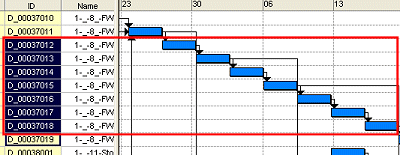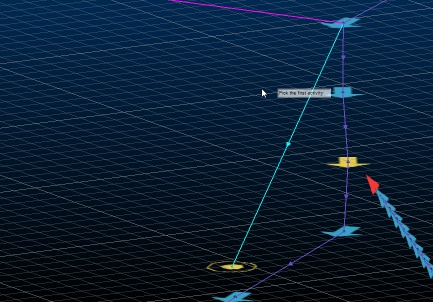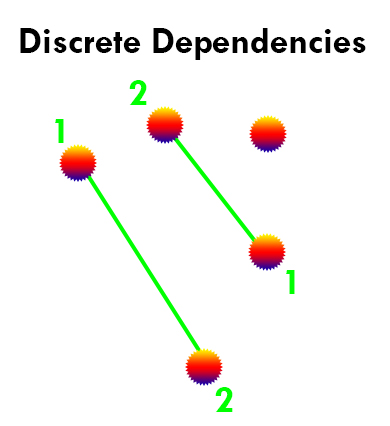Define Manual Dependencies
To access this panel:
-
The Manual Dependency Editing group of controls is found on the Dependencies panel.
This section of the Dependency Editing to interactively generate rules that will govern calculation of a sequence of mining activities.
Alternatively, apply Automatic dependencies. These are set up by clicking the Edit Rules button (Rules-based dependency creation group), which launches the Edit Dependency Rules panel.
Important: Design data must be loaded in order to define manual dependencies.
Manual dependencies are created by linking activity points interactively, selecting the predecessor and the successor of the dependency in that order. Manual dependencies can be generated from any existing activity, in a backwards or reverse direction. You define dependencies between any activity points, regardless of the underlying design type.
Tip: You can also define dependencies by interactively picking solids or outlines.
For example, a segment of an outline solid representing a stope (and containing an activity point) can be instructed to commence only after completion of the terminal activity of the access drive. Similarly, you can link complex solid and wireframe activities, or complex solid and fixed cross sectional activities, as further examples.
Manual dependencies are set by specifying points to indicate the activities to link (therefore applying the activity relationship as defined by the current layer).
An example of a manual dependency being created between activity points
Dependencies are sometimes required to change direction, opposite to the string. You can do this using the Reverse option then interactively selecting the dependency strings to reverse.
When you've finished, click Save to commit your changes to the UG database. Your changes must be saved before the Go button is enabled to allow sequencing to be applied.
You can use the Project Data group of commands to load any planning data, not just activity points and dependency strings. This group lets you independently load reference solids, points, depedencies and design outline data.
Manual Dependency Editing Methods
There are two ways to manually create dependencies in the primary 3D window:
-
Click two points in the 3D window to define a single dependency. You then get to select further pairs of points if you need to. These are Discrete dependencies and following a click point 1 - click point 2, click point 1, click point 2... pattern.
For example:
-
Click a series of points, generating dependencies between successive point positions. These are Continuous dependencies and follow a click point 1, click point 2 (creates 1-2 dependency), click point 3 (creates 2-3 dependency), click point 4 (creates 3-4 dependency)... pattern.
For example:
All dependencies need to reference an activity link type. This will determine the relationship between activities assigned to the selected dependency layer. The following dependency types can be selected:
- Finish-Start – The default dependency type - the preceding activity finishes before the next starts.
- Finish-Finish – The preceding and current activity finish at the same time.
- Start-Start – The preceding and current activity start at the same time.
- Start-Finish – The current activity finishes as the preceding one starts.
- Percent-Overlap – This is a variant of the [Finish-Start] type; the current activity starts when there is a specified % of the preceding activity yet to complete.
Defining the correct relationship between activities is an essential part of planning. For example the following activity points (represented in the DTS Gannt view) shows 7 activities, all specified with a Finish-Start relationship:

Whilst the same activities defined with a Start-Start relationship would all start simultaneously:

Any delay specified here will replace any default layer that may be assigned for the currently selected layer.
The link type is set before a manual dependency is created. It is not possible to change the relationship between activities after a manual dependency has been created (other than by manually editing the underlying dependency table, which is not advised).
To cancel a manual editing mode, click Cancel or press <Esc>. This will end the manual editing session and re-enable panel controls.
The general procedure for manually creating dependencies is:
- Load design data and rotate/zoom the view to show the area of interest (activity points and string directions will automatically be shown). Orient the view so that all areas of interest are visible (particularly, the activity points representing the predecessor and successor of each dependency you wish to define).
- Define a Layer on which to add the dependency (if it doesn't already exist). These layers are predefined. See Dependency Layers. Select the layer on which to apply the new dependency, using the drop-down list.
- Select the activity relationship, using the Link Type list. See "Manual Dependency Editing Methods", above, for more information on different activity relationships.
- If required select the amount of Delay (and unit) between the two activities to be selected. This could be useful, say, to plan a shift change contingency, for example.
-
Either draw one or more Discrete dependency strings, or a Continuous dependency string to accommodate a chain of activities. See "Manual Dependency Editing Methods", above, for more information on the different dependency assignment methods.
Tip: Use the quick keys "ddd" to enter discrete dependency drawing mode, or "ddc" to enter continuous dependency drawing mode.
- Cancel the editing mode when all dependencies are defined.
-
Select Apply Defaults if you need to reset the current dependency layer to default settings. This will remove previously applied customizations.
Tip: Use the quick keys "ddf" to enter dependency defaults application mode.
- If required, modify existing dependencies:
Reverse the direction of a dependency. After clicking the button, select the dependency to affect.
Tip: You can also use the quick keys "dre" to launch dependency reversal mode.
Move From Point or Move To Point and select a dependency. Next, select the activity that will become the new start or end position of the selected dependency. Alternatively, you can preselect dependency data in the 3D view, then this option, to update multiple dependencies at once.
Tip: Use the quick keys "dmf" to enter dependency start editing mode, or "dmt" for end editing.
-
If required, select Delete and remove any manual dependencies you no longer need.
Tip: You can also use the quick keys "ddt" to launch dependency deletion mode.
- Once dependency creation is complete, update your project using Save.
Selecting Data to Edit Dependencies
If dependency data exists, there are two ways to edit dependencies interactively using the Reverse, Delete and Apply Defaults options:
- Select the command first, with no 3D window data selected, then pick one dependency at a time to edit it.
- Select the data first (one or more dependencies) then pick a button to apply an edit. This method can be used to edit multiple dependencies simultaneously.
Related topics and activities




